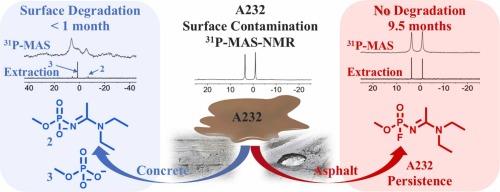Fate and Decontamination of Novichok Agent A232 on Environmental and Urban Matrices
IF 11.3
1区 环境科学与生态学
Q1 ENGINEERING, ENVIRONMENTAL
引用次数: 0
Abstract
Novichoks are highly toxic chemical warfare agents (CWAs), which gained significant attention after being used in the assassination attempt of Sergei Skripal (2018, Salisbury). Since then, only a limited number of experimental studies on Novichoks were conducted with focus on their physicochemical properties, toxicology and pharmacology. Their stability on various matrices has received even minor consideration. Herein, we present a comprehensive study on the fate of A232, a prominent Novichok agent, on a variety of previously unexamined environmental and urban matrices, using solid and solution state 31P-NMR techniques. The matrices studied included limestone soil, desert soil, silicate sand, asphalt, fresh and old concrete and sawdust, all in dry and wet forms. A232 was found to be highly persistent on most matrices, with degradation being very slow or nonexistent. Once degradation occurred, its products stemmed from either a P-N bond or a P-F bond cleavage or double hydrolysis of both leaving groups, depending on the matrix. The results indicate that A232 poses significant, long-term threat to the environment across a diverse range of realistic scenarios. Importantly, A232 adsorbed on solid support was rapidly and completely hydrolyzed to a nontoxic product once treated with only a few equivalents of NaOH.

诺维乔克药剂A232在环境和城市基质上的去除率和去污性能
诺维乔克是剧毒的化学战剂(CWAs),在暗杀谢尔盖·斯克里帕尔(Sergei Skripal)未遂事件中使用后引起了极大的关注(2018年,索尔兹伯里)。此后,对诺维乔克的实验研究数量有限,主要集中在其理化性质、毒理学和药理学方面。它们在各种矩阵上的稳定性甚至很少得到考虑。在此,我们提出了一项关于A232的命运的综合研究,一种突出的诺维乔克剂,在各种以前未经研究的环境和城市基质上,使用固体和溶液状态31P-NMR技术。研究的基质包括石灰石土壤、沙漠土壤、硅酸盐砂、沥青、新鲜和旧的混凝土和锯末,它们都以干和湿的形式存在。发现A232在大多数矩阵上具有高度持久性,降解非常缓慢或不存在。一旦发生降解,其产物源于P-N键或P-F键的裂解或两个离去基团的双水解,具体取决于基质。研究结果表明,在各种现实场景中,A232对环境构成了重大的长期威胁。重要的是,吸附在固体载体上的A232一旦用少量的NaOH处理,就能迅速完全水解成无毒产物。
本文章由计算机程序翻译,如有差异,请以英文原文为准。
求助全文
约1分钟内获得全文
求助全文
来源期刊

Journal of Hazardous Materials
工程技术-工程:环境
CiteScore
25.40
自引率
5.90%
发文量
3059
审稿时长
58 days
期刊介绍:
The Journal of Hazardous Materials serves as a global platform for promoting cutting-edge research in the field of Environmental Science and Engineering. Our publication features a wide range of articles, including full-length research papers, review articles, and perspectives, with the aim of enhancing our understanding of the dangers and risks associated with various materials concerning public health and the environment. It is important to note that the term "environmental contaminants" refers specifically to substances that pose hazardous effects through contamination, while excluding those that do not have such impacts on the environment or human health. Moreover, we emphasize the distinction between wastes and hazardous materials in order to provide further clarity on the scope of the journal. We have a keen interest in exploring specific compounds and microbial agents that have adverse effects on the environment.
 求助内容:
求助内容: 应助结果提醒方式:
应助结果提醒方式:


